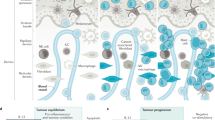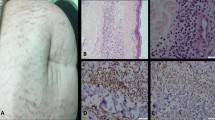Abstract
Squamous cell carcinoma (SCC) is the most common skin cancer in patients receiving immunosuppressive therapy, and is well documented to occur in patients that have undergone either solid organ transplantation or conventional myeloablative bone marrow transplantation. Nonmyeloablative hematopoietic cell transplantation (NMAT) provides transient, intensive immunosuppression, permitting allogeneic engraftment without ablating the marrow. The purpose of this report is to describe six patients that developed SCC (n=3), basal cell carcinoma (n=2), or malignant melanoma (n=2) over a period of 2–26 months following NMAT. All patients had myelodysplasia or acute myelogenous leukemia prior to transplantation. The authors demonstrate for the first time that patients who undergo NMAT are at risk for developing skin cancers and emphasize the need for close surveillance in the post transplantation period.
This is a preview of subscription content, access via your institution
Access options
Subscribe to this journal
Receive 12 print issues and online access
$259.00 per year
only $21.58 per issue
Buy this article
- Purchase on Springer Link
- Instant access to full article PDF
Prices may be subject to local taxes which are calculated during checkout
Similar content being viewed by others
References
Landis SH, Murray T, Bolden S, Wingo PA . Cancer statistics, 1999. CA Cancer J Clin 1999; 49: 8–31.
Rhodes AR . Public education and cancer of the skin. What do people need to know about melanoma and nonmelanoma skin cancer? Cancer 1995; 75: 613–636.
Marks R . An overview of skin cancers. Incidence and causation. Cancer 1995; 75: 607–612.
Berg D, Otley CC . Skin cancer in organ transplant recipients: epidemiology, pathogenesis, and management. J Am Acad Dermatol 2002; 47: 1–17.
Walder BK, Robertson MR, Jeremy D . Skin cancer and immunosuppression. Lancet 1971; 2: 1282–1283.
Kanitakis J, Alhaj-Ibrahim L, Euvrard S, Claudy A . Basal cell carcinomas developing in solid organ transplant recipients: clinicopathologic study of 176 cases. Arch Dermatol 2003; 139: 1133–1137.
Ramsay HM, Fryer AA, Hawley CM, Smith AG, Harden PN . Non-melanoma skin cancer risk in the Queensland renal transplant population. Br J Dermatol 2002; 147: 950–956.
Ramsay HM, Fryer AA, Hawley CM, Smith AG, Nicol DL, Harden PN . Factors associated with nonmelanoma skin cancer following renal transplantation in Queensland, Australia. J Am Acad Dermatol 2003; 49: 397–406.
Lindelof B, Sigurgeirsson B, Gabel H, Stern RS . Incidence of skin cancer in 5356 patients following organ transplantation. Br J Dermatol 2000; 143: 513–519.
Hasegawa W, Pond GR, Rifkind JT, Messner HA, Lau A, Daly AS et al. Long-term follow-up of secondary malignancies in adults after allogeneic bone marrow transplantation. Bone Marrow Transplant 2005; 35: 51–55.
Lishner M, Patterson B, Kandel R, Fyles G, Curtis JE, Meharchand J et al. Cutaneous and mucosal neoplasms in bone marrow transplant recipients. Cancer 1990; 65: 473–476.
Gmeinhart B, Hinterberger W, Greinix HT, Rabitsch W, Kirnbauer R, Reiter E et al. Anaplastic squamous cell carcinoma (SCC) in a patient with chronic cutaneous graft-versus-host disease (GVHD). Bone Marrow Transplant 1999; 23: 1197–1199.
Curtis RE, Rowlings PA, Deeg HJ, Shriner DA, Socie G, Travis LB et al. Solid cancers after bone marrow transplantation. N Engl J Med 1997; 336: 897–904.
Curtis RE, Metayer C, Rizzo JD, Socie G, Sobocinski KA, Flowers ME et al. Impact of chronic GVHD therapy on the development of squamous cell cancers after hematopoietic stem-cell transplantation: an international case-control study. Blood 2005; 105: 3802–3811.
Bhatia S, Ramsay NK, Steinbuch M, Dusenbery KE, Shapiro RS, Weisdorf DJ et al. Malignant neoplasms following bone marrow transplantation. Blood 1996; 87: 3633–3639.
Giralt S, Estey E, Albitar M, van Besien K, Rondon G, Anderlini P et al. Engraftment of allogeneic hematopoietic progenitor cells with purine analog-containing chemotherapy: harnessing graft-versus-leukemia without myeloablative therapy. Blood 1997; 89: 4531–4536.
Khouri IF, Keating M, Korbling M, Przepiorka D, Anderlini P, O’Brien S et al. Transplant-lite: induction of graft-versus-malignancy using fludarabine-based nonablative chemotherapy and allogeneic blood progenitor-cell transplantation as treatment for lymphoid malignancies. J Clin Oncol 1998; 16: 2817–2824.
Slavin S, Nagler A, Naparstek E, Kapelushnik Y, Aker M, Cividalli G et al. Nonmyeloablative stem cell transplantation and cell therapy as an alternative to conventional bone marrow transplantation with lethal cytoreduction for the treatment of malignant and nonmalignant hematologic diseases. Blood 1998; 91: 756–763.
Childs R, Clave E, Contentin N, Jayasekera D, Hensel N, Leitmen S et al. Engraftment kinetics after nonmyeloablative allogeneic peripheral blood stem cell transplantation: full donor T-cell chimerism precedes alloimmune responses. Blood 1999; 94: 3234–3241.
Storb R, Yu C, Sandmaier BM, McSweeney PA, Georges G, Nash RA et al. Mixed hematopoietic chimerism after marrow allografts. Transplantation in the ambulatory care setting. Ann NY Acad Sci 1999; 872: 372–376.
Grigg A, Seymour JF, Roberts A, Szer J . Mini-allografts’ for haematological malignancies: an alternative to conventional myeloablative marrow transplantation. Aust NZ J Med 1999; 29: 308–314.
Champlin R, Khouri I, Shimoni A, Gajewski J, Kornblau S, Molldrem J et al. Harnessing graft-versus-malignancy: non-myeloablative preparative regimens for allogeneic haematopoietic transplantation, an evolving strategy for adoptive immunotherapy. Br J Haematol 2000; 111: 18–29.
Sakiyama M, Kami M, Hori A, Imataki O, Hamaki T, Murashige N et al. Regimen-related toxicity following reduced-intensity stem-cell transplantation (RIST): comparison between Seattle criteria and National Cancer Center Common Toxicity Criteria (NCI-CTC) version 2.0. Bone Marrow Transplant 2004; 34: 787–794.
Sullivan KM . Acute and chronic graft-versus-host disease in man. Int J Cell Cloning 1986; 4: 42–93.
Socie G . Chronic graft-versus-host disease: clinical features and grading systems. Int J Hematol 2004; 79: 216–220.
Hurley CK, Baxter Lowe LA, Logan B, Karanes C, Anasetti C, Weisdorf D et al. National Marrow Donor Program HLA-matching guidelines for unrelated marrow transplants. Biol Blood Marrow Transplant 2003; 9: 610–615.
Nelson Jr RP, Robertson MJ, Cripe LD, Hromas R, Schwartz JE, Yu M et al. Outcomes after matched related and unrelated nonmyeloablative allotransplantation for advanced hematological malignancies. Am J Hematol 2006, submitted.
Martinez JC, Otley CC, Stasko T, Euvrard S, Brown C, Schanbacher CF et al. Defining the clinical course of metastatic skin cancer in organ transplant recipients: a multicenter collaborative study. Arch Dermatol 2003; 139: 301–306.
Randle HW . The historical link between solid-organ transplantation, immunosuppression, and skin cancer. Dermatol Surg 2004; 30: 595–597.
Jensen P, Hansen S, Moller B, Leivestad T, Pfeffer P, Fauchald P et al. Are renal transplant recipients on CsA-based immunosuppressive regimens more likely to develop skin cancer than those on azathioprine and prednisolone? Transplant Proc 1999; 31: 1120.
Jensen P, Hansen S, Moller B, Leivestad T, Pfeffer P, Geiran O et al. Skin cancer in kidney and heart transplant recipients and different long-term immunosuppressive therapy regimens. J Am Acad Dermatol 1999; 40 (2 Part 1): 177–186.
Otley CC, Pittelkow MR . Skin cancer in liver transplant recipients. Liver Transplant 2000; 6: 253–262.
Lober BA, Lober CW, Accola J . Actinic keratosis is squamous cell carcinoma. J Am Acad Dermatol 2000; 43: 881–882.
Szeto CH, Shek TW, Lie AK, Au WY, Yuen AP, Kwong YL . Squamous cell carcinoma of the tongue complicating chronic oral mucosal graft-versus-host disease after allogeneic hematopoietic stem cell transplantation. Am J Hematol 2004; 77: 200–202.
Fortina AB, Piaserico S, Zattra E, Alaibac M . Dermoscopic features of eruptive melanocytic naevi in an adult patient receiving immunosuppressive therapy for Crohn’s disease. Melanoma Res 2005; 15: 223–224.
Austin AS, Spiller RC . Inflammatory bowel disease, azathioprine and skin cancer: case report and literature review. Eur J Gastroenterol Hepatol 2001; 13: 193–194.
Chun HG, Leyland-Jones B, Cheson BD . Fludarabine phosphate: a synthetic purine antimetabolite with significant activity against lymphoid malignancies. J Clin Oncol 1991; 9: 175–188.
Goodman ER, Fiedor PS, Fein S, Athan E, Hardy MA . Fludarabine phosphate: a DNA synthesis inhibitor with potent immunosuppressive activity and minimal clinical toxicity. Am Surg 1996; 62: 435–442.
Boldt DH, Von Hoff DD, Kuhn JG, Hersh M . Effects on human peripheral lymphocytes of in vivo administration of 9-beta-D-arabinofuranosyl-2-fluoroadenine-5′-monophosphate (NSC 312887), a new purine antimetabolite. Cancer Res 1984; 44: 4661–4666.
Keating MJ, O’Brien S, Lerner S, Koller C, Beran M, Robertson LE et al. Long-term follow-up of patients with chronic lymphocytic leukemia (CLL) receiving fludarabine regimens as initial therapy. Blood 1998; 92: 1165–1171.
Larsen CR, Hansen PB, Clausen NT . Aggressive growth of epithelial carcinomas following treatment with nucleoside analogues. Am J Hematol 2002; 70: 48–50.
Davidovitz Y, Ballin A, Meytes D . Flare-up of squamous cell carcinoma of the skin following fludarabine therapy for chronic lymphocytic leukemia. Acta Haematol 1997; 98: 44–46.
Rashid K, Ng R, Mastan A, Sager D, Hirschman R . Accelerated growth of skin carcinoma following fludarabine therapy for chronic lymphocytic leukemia. Leuk Lymphoma 2005; 46: 1051–1055.
Gillison ML, Shah KV . Human papillomavirus-associated head and neck squamous cell carcinoma: mounting evidence for an etiologic role for human papillomavirus in a subset of head and neck cancers. Curr Opin Oncol 2001; 13: 183–188.
Scheffner M, Werness BA, Huibregtse JM, Levine AJ, Howley PM . The E6 oncoprotein encoded by human papillomavirus types 16 and 18 promotes the degradation of p53. Cell 1990; 63: 1129–1136.
Kessis TD, Slebos RJ, Nelson WG, Kastan MB, Plunkett BS, Han SM et al. Human papillomavirus 16 E6 expression disrupts the p53-mediated cellular response to DNA damage. Proc Natl Acad Sci USA 1993; 90: 3988–3992.
Jones DL, Munger K . Analysis of the p53-mediated G1 growth arrest pathway in cells expressing the human papillomavirus type 16 E7 oncoprotein. J Virol 1997; 71: 2905–2912.
Kutler DI, Wreesmann VB, Goberdhan A, Ben-Porat L, Satagopan J, Ngai I et al. Human papillomavirus DNA and p53 polymorphisms in squamous cell carcinomas from Fanconi anemia patients. J Natl Cancer Inst 2003; 95: 1718–1721.
Ziegler A, Jonason AS, Leffell DJ, Simon JA, Sharma HW, Kimmelman J et al. Sunburn and p53 in the onset of skin cancer. Nature 1994; 372: 773–776.
Soehnge H, Ouhtit A, Ananthaswamy ON . Mechanisms of induction of skin cancer by UV radiation. Front Biosci 1997; 2: 538–551.
Author information
Authors and Affiliations
Corresponding author
Rights and permissions
About this article
Cite this article
Cavalier, M., Shmalo, J., Yu, M. et al. Skin cancer after nonmyeloablative hematopoietic cell transplantation. Bone Marrow Transplant 37, 1103–1108 (2006). https://doi.org/10.1038/sj.bmt.1705362
Received:
Revised:
Accepted:
Published:
Issue Date:
DOI: https://doi.org/10.1038/sj.bmt.1705362
Keywords
This article is cited by
-
Increased incidence of chronic GvHD and CMV disease in patients with vitamin D deficiency before allogeneic stem cell transplantation
Bone Marrow Transplantation (2015)
-
Concurrent malignant melanoma and cutaneous involvement by classical hodgkin lymphoma (CHL) in a 63 year-old man
Diagnostic Pathology (2013)
-
Secondary malignancies after allogeneic stem-cell transplantation in the era of reduced-intensity conditioning; the incidence is not reduced
Leukemia (2013)
-
Long-term disease-free survival after nonmyeloablative cyclophosphamide/fludarabine conditioning and related/unrelated allotransplantation for acute myeloid leukemia/myelodysplasia
Bone Marrow Transplantation (2010)



